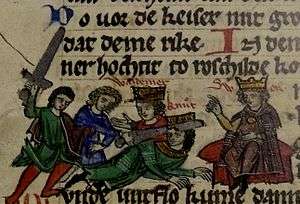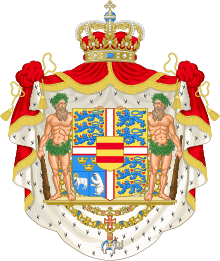Canute V of Denmark
| Canute V | |||||
|---|---|---|---|---|---|
|
Bracteate from the reign of Canute V. | |||||
| King of Denmark | |||||
| Reign | 1146–1157[1] | ||||
| Predecessor | Eric III Lamb | ||||
| Successor | Valdemar I the Great | ||||
| Born | c. 1129 | ||||
| Died |
9 August 1157 (aged 27–28) | ||||
| Consort | Helena of Sweden | ||||
| Issue among others... |
Saint Niels (illegitimate) Valdemar, Bishop of Schleswig (illegitimate) Brigitte, Countess of Anhalt (illegitimate) Hildegard, Princess of Rügen (illegitimate) Ingrid, Duchess of Pomerania (illegitimate) | ||||
| |||||
| House | Estridsen | ||||
| Father | Magnus I of Sweden | ||||
| Mother | Richeza of Poland | ||||
| Religion | Roman Catholicism | ||||
Canute V Magnussen (Danish: Knud V Magnussen) (c. 1129 – 9 August 1157) was a King of Denmark from 1146 to 1157, as co-regent in shifting alliances with his Sweyn III and Valdemar I. Canute was killed at the so-called Bloodfeast of Roskilde in 1157. Nothing certain is known about his person and character.
Biography
Canute was born around 1129, the son of King Niels' son Magnus I of Sweden. After the abdication of Eric III in 1146, the magnates of Jutland declared Canute king, while the magnates of Zealand and Scania crowned Sweyn III,[2] the nephew of Canute Lavard who Magnus had killed in 1131.[1]
In the following years, Canute tried in vain to defeat Sweyn III on Zealand for complete control over Denmark. In 1147, Canute and Sweyn united to undertake the Wendish Crusade, which however ended in the re-ignition of their strife.[3] Sweyn and his cousin Duke Valdemar, the son of Canute Lavard, defeated Canute in Jutland in 1150, and Canute fled to his father-in-law Sverker I of Sweden. Canute attempted a number of reconquests, all of them unsuccessful, and turned to Frederick Barbarossa for help. The resulting compromise of 1152, which was supported by Valdemar, made Canute the inferior co-regent of Sweyn. However, Sweyn decided not to effectuate the deal[3]
Canute now formed an alliance with Valdemar and Sverker, whose daughter Helena of Sweden Canute was to marry. Sweyn fled Denmark in 1154, and Canute struck a deal with Valdemar, making him his co-ruler under the name Valdemar I. Canute was an inferior king to Valdemar,[3] and after Sweyn's re-entry into Denmark, a final compromise was struck in 1157, under pressure from the Danish magnates.[2] Sweyn, Canute, and Valdemar were set up as co-rulers, with Canute ruling Zealand.[3] During the peace banquet in Roskilde on 9 August 1157, later known as the Bloodfeast of Roskilde, Sweyn attempted to kill both Canute and Valdemar.[2] Canute was allegedly killed by one of Sweyn's warriors.[3]

Canute's half-sister Sofia of Minsk married Valdemar, who avenged him the same year by killing Sweyn at the Battle of Grathe Heath to win Denmark for himself.
Issue
Not more than a year before his death, Canute married Helena of Sweden, but they had no children.[3] Canute fathered a number of children out of wedlock:[3]
- Saint Niels of Aarhus (died 1180); he lived as monk[4]
- Knud[5]
- Valdemar; he was Bishop of Schleswig and Prince-Archbishop of Bremen
- Brigitte (or Jutta); she married Bernhard, Count of Anhalt
- Hildegard; she married Jaromar I, Prince of Rugia
- Ingerd; she married Casimir II, Duke of Pomerania
- Another daughter; she married Bogislaw III of Schlawe
Ancestry
| Ancestors of Canute V of Denmark | |||||||||||||||||||||||||||||||||||||||||||||||||||||||||||||||||||||||||||||||||||||||||||||||||||||||||||||||||||||||||||||||||||||||||||||||||||||||||||||||||||||||||||||||||||||||||||||||||||||||||||||||||||||||||||||||||||||||||||||||||||||||||||||||||||||||||||||||||||||||||||||||||||||||||||||||||||||||||||||||||||||||||||||||||||||||||||||||||||||||||||||||||||||||||||||||||||||||||||||||||||||||||||||||||||||||||||||||||||||||||||||||||||||
|---|---|---|---|---|---|---|---|---|---|---|---|---|---|---|---|---|---|---|---|---|---|---|---|---|---|---|---|---|---|---|---|---|---|---|---|---|---|---|---|---|---|---|---|---|---|---|---|---|---|---|---|---|---|---|---|---|---|---|---|---|---|---|---|---|---|---|---|---|---|---|---|---|---|---|---|---|---|---|---|---|---|---|---|---|---|---|---|---|---|---|---|---|---|---|---|---|---|---|---|---|---|---|---|---|---|---|---|---|---|---|---|---|---|---|---|---|---|---|---|---|---|---|---|---|---|---|---|---|---|---|---|---|---|---|---|---|---|---|---|---|---|---|---|---|---|---|---|---|---|---|---|---|---|---|---|---|---|---|---|---|---|---|---|---|---|---|---|---|---|---|---|---|---|---|---|---|---|---|---|---|---|---|---|---|---|---|---|---|---|---|---|---|---|---|---|---|---|---|---|---|---|---|---|---|---|---|---|---|---|---|---|---|---|---|---|---|---|---|---|---|---|---|---|---|---|---|---|---|---|---|---|---|---|---|---|---|---|---|---|---|---|---|---|---|---|---|---|---|---|---|---|---|---|---|---|---|---|---|---|---|---|---|---|---|---|---|---|---|---|---|---|---|---|---|---|---|---|---|---|---|---|---|---|---|---|---|---|---|---|---|---|---|---|---|---|---|---|---|---|---|---|---|---|---|---|---|---|---|---|---|---|---|---|---|---|---|---|---|---|---|---|---|---|---|---|---|---|---|---|---|---|---|---|---|---|---|---|---|---|---|---|---|---|---|---|---|---|---|---|---|---|---|---|---|---|---|---|---|---|---|---|---|---|---|---|---|---|---|---|---|---|---|---|---|---|---|---|---|---|---|---|---|---|---|---|---|---|---|---|---|---|---|---|---|---|---|---|---|---|---|---|---|---|---|---|---|---|---|---|---|---|---|---|---|---|---|---|---|---|---|---|---|---|---|---|---|---|---|---|---|---|---|---|---|---|---|---|---|---|---|---|---|---|---|---|---|---|---|---|---|---|---|---|
| |||||||||||||||||||||||||||||||||||||||||||||||||||||||||||||||||||||||||||||||||||||||||||||||||||||||||||||||||||||||||||||||||||||||||||||||||||||||||||||||||||||||||||||||||||||||||||||||||||||||||||||||||||||||||||||||||||||||||||||||||||||||||||||||||||||||||||||||||||||||||||||||||||||||||||||||||||||||||||||||||||||||||||||||||||||||||||||||||||||||||||||||||||||||||||||||||||||||||||||||||||||||||||||||||||||||||||||||||||||||||||||||||||||
References
![]() Media related to Canute V of Denmark at Wikimedia Commons
Media related to Canute V of Denmark at Wikimedia Commons
- 1 2 Monarkiet i Danmark – Kongerækken at The Danish Monarchy
- 1 2 3 Knud 5. Magnussen at Gyldendals Åbne Encyklopædi
- 1 2 3 4 5 6 7 Bricka, Carl Frederik (ed.), Dansk Biografisk Lexikon, vol. IX [Jyde – Køtschau], 1895. "Knud (Magnussen)", Hans Olrik, pp.263–264.
- ↑ Skt. Niels af Århus (11??-1180) Archived July 16, 2011, at the Wayback Machine. by Aarhus Municipal Library
- ↑ Kings and Queens of Denmark – Knud III at JMarcussen.dk
| Canute V Born: ca. 1129 Died: 9 August 1157 | ||
| Regnal titles | ||
|---|---|---|
| Preceded by Eric Lamb |
King of Denmark 1146–1157 with Sweyn Grathe & Valdemar the Great |
Succeeded by Valdemar the Great |

